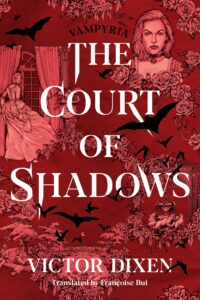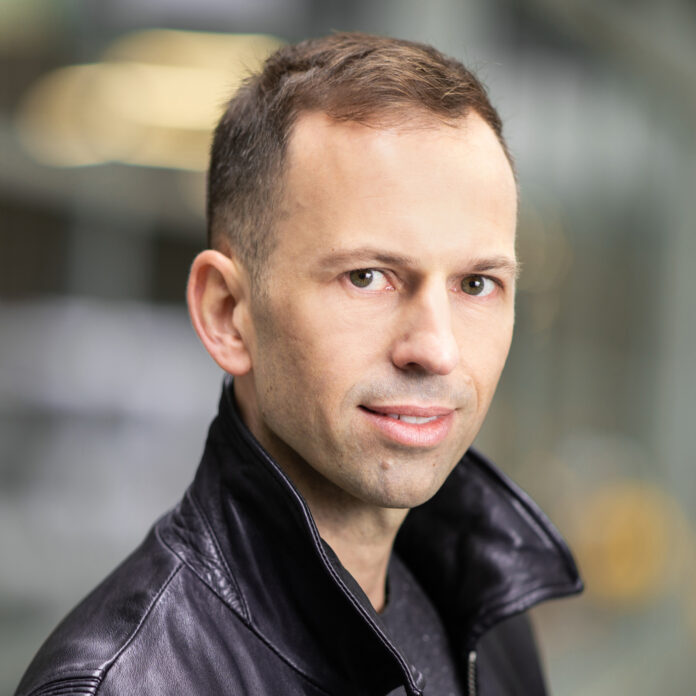Q. The English translation of your novel, The Court of Shadows, is releasing TODAY! How did this series come about?
After the fantasy of Animale, after the science fiction of Phobos, Cogito and Extincta, I had a furious desire to delve, in my own way, into a genre I love: horror—more specifically, Gothic horror.
This desire met up with two others. One, a desire to write about Versailles and the Grand Siècle, a page in history that really interests me; and two, a desire to offer my own interpretation of the mythic vampire who’s made me dream and shiver over the course of so many books since my adolescence.
Q. Can you say a few words about the plot?
In the year 1715 of the old calendar, the Sun King transmuted himself into a vampyre in order to become the King of Shadows. Since then, he rules as an absolute despot on the Vampyria—a vast coalition forever frozen in an Age of Darkness, that comprises France and all of its lesser kingdoms. An iron yoke is imposed on the people who live in terror and are literally bled to feed the vampyric aristocracy.
Three centuries later, Jeanne is taken from her family of commoners and catapulted into the school that trains young nobles before they make their entrance at the Court. Between the intrigues of the living-dead at the palace, the betrayals of other students, and the abominations that abound under all the gilt of Versailles, how long will Jeanne stay alive?
Q.The series is presented as being “epic and horrific,” but also as a “paranoid game of masks and spine-tingling terror.” This seems a lot darker than the Phobos and Animale series. Did you want to try new things?
There’s often a “dark” aspect to my novels; I like exploring the shadows, both as a reader and as an author. In writing this novel, I was inspired by the Baroque aesthetic of the Grand Siècle: the dark paintings, the vanities, and the memento mori.
Essentially, this story is a way for me to tackle an icon that has always fascinated me: the vampire. The vampire is, in fact, the supreme literary creation, truly immortal, always reborn from its ashes, from century to century, from book to book.
As an adolescent, I immersed myself in Bram Stocker’s Dracula, and also Sheridan Le Fanu’s Carmilla, and Anne Rice’s Vampire Chronicles.
Today, I feel the need for a new incarnation of the vampire—alchemic, bogged down in all the layers of the past. A “vampyre” both terrifying and fascinating, all at once, who questions our relationship with time. Beyond the pure horror-filled shivers in Vampyria, I tackle a question that’s of profound interest to me: the course of history and of progress.
Q. In Book #1, readers are thrust into the court of the Sun King in 1715 (year of his historic death). Why choose this period? This pivotal moment?
I’ve long been interested in the Grand Siècle, which, for many historians, goes all the way up to the death of Louis XIV in 1715, a date that I hold firm too as well. It’s an absolutely pivotal moment in our history, one that brims with paradoxes. It’s the time of Descartes, of Pascal, and of the advent of reason, which prefigured the Age of Enlightenment. But paradoxically, it’s also an age of darkness, with an incredible resurgence of superstitions and of the occult. Witchcraft was never more practiced in France than under Louis XIV (the lurid Affair of the Poisons bears witness), while in Spain, the Inquisition reached its sinister apogee, and in America, suspected witches were burned in Salem. It’s as if humanity’s dark dreams made a tremendous comeback in this period. It’s a subject matter that appeals to me— especially through the prism of our own period, which between conspiracy theories and fake news, is itself under threat from a rise in irrationality.
Beyond these mystical manifestations, on a cultural, political and social level, the Grand Siècle shaped France into what it is today: centralization of power, development of architecture and the arts, the rise of gastronomy, and the art of living. But here again, there’s a paradox: the unsavory side of Louis XIV’s luminous reign—its religious intolerance (revocation of the Edict of Nantes), and abject inequality (enactment of the Code Noir in the colonies).
Finally, the last paradox relates to Louis XIV’s own personality. He was a human being who lived his life entirely in the public eye, centuries before the onset of social media, but whose inner-workings remain a mystery. Show all to hide . . . what? It’s precisely what I’ve tried to imagine, offering my interpretation of this complex historical figure about whom countless texts exist, none of which reveal the man.
So, by way of an alternate history, I wanted to question the Grand Siècle, this monument of history books, honoring its splendors and holding it accountable for its crimes.
Q. What were your sources of inspiration (films, books)? Did you have to do a lot of research?
As I said, the Grand Siècle is a period that has appealed to me for a long time and one which I read a lot about. I also did part of my education in Versailles. This allowed me to become very familiar with the château and the town which, even today, lives in its shadow. Such is the pull of this stone mirage as conceived by the Sun King: three centuries later, the very word “Versailles” still makes one dream, everywhere in the world!
As for historical research, other than actual visits, I recommend the Dictionnaire du Grand Siècle (Fayard)—the bible on that period. For a lighter read, but very useful to glimpse Versailles from the inside, right by Louis XIV’s side: Le Roi-Soleil Se Lève Aussi (Philippe Beaussant, Gallimard). For the dark period of the reign, I recommend the very well-done study, 1679-1682, L’Affaire des Poisons (Arlette Lebigre, Éditions Complexe). For the bright side of things, I recommend the English essay, The Essence of Style: How the French Invented High Fashion, Fine Food, Chic Cafes, Style, Sophistication, and Glamour (Joan DeJean, Free Press), which shows the ongoing fascination that Versailles continues to exert over us today. Lastly, how could I not mention a literary marvel that I fell in love with, L’Allée du Roi (Françoise Chandernagor, Gallimard), an imagined autobiography of Madame de Maintenon, an ode to the Grand Siècle and its language!
As for my artistic inspirations, I let myself be guided by three giants whom I admire. Anne Rice for intoxicating Gothic ambiance and for characters with psychological depth. Alexandre Dumas for a resolutely French inspiration as well as the breadth of epic adventure. And last, Quentin Tarantino for frenzied pacing, the eruption of “pop” patterns in the narrative, and psychological tension.
Q. How did you handle your world-building? Did you know from the opening paragraphs how the plot would unfold and what your characters’ destinies would be?
As with all alternate storylines, the point of departure was the question “What if . . . ?” – What if Louis XIV had never left the throne? School textbooks teach us that Louis the Great reigned for the longest period in all of French history. I simply imagined a world in which his reign would have lasted until present day. And not just his reign, but all the social hierarchy, culture, “science,” and value system of the Grand Siècle. Fantasy made this hypothesis possible, and the vampire aspect made it terrifying!
And so, I knew that I had to go in search of this dark world side-by-side with an “outsider” character, someone who’d discover with me the details and the behind-the-scenes goings-on. That’s how Jeanne was born. I wanted to make her a romantic heroine, both passionate and tormented (as the ancient medical and alchemical theory of the humors, which runs through the entire world of the novel; Jeanne is diagnosed “half-sanguine, half-melancholic” due to a surplus of blood and a surplus of black bile). She feels constrained in her village, in her time period, in her world where all horizons are blocked. In creating her, I thought about the sources of Romanticism, the “mal du siècle”—the “scourge of the century” that haunted young people in the generation of Musset, Chateaubriand, and Hugo. But Jeanne carries within her the scourge of three centuries that remained at a standstill since the transmutation of the King of Shadows!
This brings me to the theme of Time, which permeates the entire series. It’s the reason why I decided to write about an alternate world. Today, we live in a world torn between an uncertain future and a return of fears stemming from the depths of human the psyche and from the past. Pandemic, threats to democracy, a deepening of social inequalities . . . the world seems truly scary. How can you be young in a world menaced by the past? How can you make the future happen? I summoned the absolute authoritarian figure, the Sun King, and I made him even more crushing: I made him immortal.
In this first book, but also in the entire saga, my heroine’s battle against the eternal reign of vampires is the fight young people wage to exist.
Q. What are you currently working on and what’s to come?
I’ve already buckled down and begun the next book in the Vampyria saga. My nights are filled with writing! I have an immense desire to explore the Magna Vampyria, the empire over which the King of Shadows reigns—probing its most hidden secrets . . . the most dangerous ones.
 A fiery heroine seeks vengeance against a royal court of deadly vampires in this epic alternate history set in lavish Versailles.
A fiery heroine seeks vengeance against a royal court of deadly vampires in this epic alternate history set in lavish Versailles.
Louis XIV transformed from the Sun King into the King of Shadows when he embraced immortality and became the world’s first vampire. For the last three centuries, he has been ruling the kingdom from the decadent Court of Shadows in Versailles, demanding the blood of his subjects to sate his nobles’ thirst and maintain their loyalty.
In the heart of rural France, commoner Jeanne Froidelac witnesses the king’s soldiers murder her family and learns of her parents’ role in a brewing rebellion involving the forbidden secrets of alchemy. To seek her revenge, Jeanne disguises herself as an aristocrat and enrolls in a prestigious school for aspiring courtiers. She soon finds herself at the doors of the palace of Versailles.
But Jeanne, of course, is no aristocrat. She dreams not of court but of blood.
The blood of a king.






